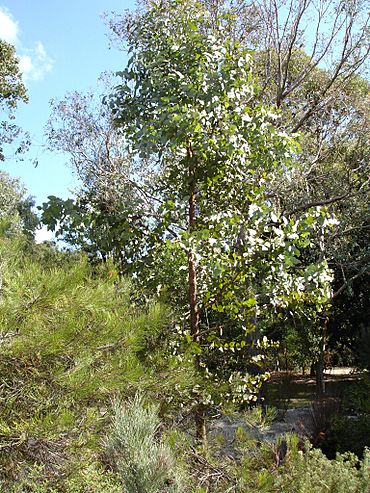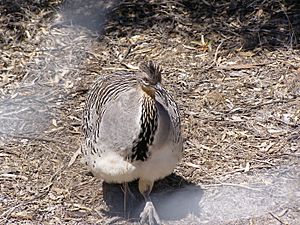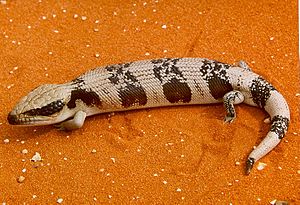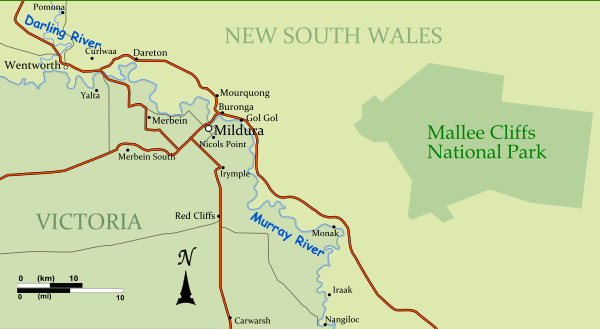Mallee Cliffs National Park facts for kids
Quick facts for kids Mallee Cliffs National ParkNew South Wales |
|
|---|---|
|
IUCN Category II (National Park)
|
|

White mallee
|
|
| Nearest town or city | Mildura, Victoria |
| Established | April 1977 |
| Area | 57,969 ha (143,240 acres) |
| Visitation | Restricted public access for education purposes |
| Managing authorities | NSW National Parks & Wildlife Service |
| Website | Mallee Cliffs National Park |
| See also | Protected areas of New South Wales |
The Mallee Cliffs National Park is a special protected area in the south-west of New South Wales, Australia. It's like a huge natural playground, covering about 57,969 hectares. This national park is located about 790 kilometers west of Sydney. It's also only 30 kilometers east of Mildura, a city near the Murray River in Victoria.
Contents
History of the Park
The Mallee Cliffs National Park was created in 1977. A group called the Foundation for National Parks & Wildlife bought the land to protect it. The main goal of this park is to look after the unique "Mallee Country". This includes sandy plains and sand dunes. It's especially important for protecting wildlife, particularly the amazing malleefowl.
Visiting the Park
This park is usually closed to the public. This helps protect the malleefowl and other rare animals living there. It also helps the park meet its other conservation goals. Only schools, colleges, and researchers can visit. Their visits must be for educational activities or research that helps manage the park.
Park Environment
Geography of Mallee Cliffs
The Mallee Cliffs National Park protects the original red clay plains of south-west New South Wales. It has large areas of flat to gently rolling sandy plains. There are also long sand dunes that formed a very long time ago. These dunes were created during dry periods between 350,000 and 500,000 years ago.
Plants of the Park
The park protects untouched areas of mallee vegetation. It also has rosewood-belah woodlands. Mallee are small eucalyptus trees and shrubs. They have many small stems and thick underground roots that hold water. Before irrigation farming started, thick groups of mallee trees covered much of north-western Victoria. They also covered parts of south-western New South Wales.
The park has important examples of mallee communities. These include both bull mallee and whipstick mallee. These types of plants are often cleared on private land for grazing animals. This makes the park even more important for protecting them. The park also has some isolated plant groups. These show how plants have changed over a long time due to environmental shifts.
In January 1975, a large bushfire burned through this region. Because of this fire, the plants in the park are generally younger than in similar protected areas. This means the park is not ideal for some animals, like the black-eared miner. These birds prefer older trees and mallee bushes for their homes.
Animals of the Park
The Mallee Cliffs National Park is part of the Southern NSW Mallee Important Bird Area. This area is known for supporting a large number of vulnerable malleefowl. The park is the only protected area in New South Wales that has malleefowl habitat. Malleefowl only live in dry areas where mallee trees grow.
Malleefowl Life Cycle
The male malleefowl builds a special nest for the eggs. In winter, he digs a large pit. Over the next four months, he fills it with leaves and grass. The female lays one egg each day for several days in the spring. Then, the male covers the mound with sand. The rotting leaves and grass inside the mound create heat. The male watches over the mound carefully. He tests the temperature with his tongue, adding or removing sand as needed.
When a chick hatches, it digs its way out of the mound. Once they reach the top, they are known for standing still for up to twenty minutes. Then, they race or stagger off into the bush. Malleefowl chicks hatch with feathers and can take care of themselves right away. They do not need any help from their parents. Adult malleefowl grow to be about 60 centimeters long.
Other Animals
Several types of small birds live in the park, as well as emus. Mammals include a large group of western grey kangaroos. There are also pygmy possums and two types of bats: the little pied bat and the greater long-eared bat. These bats use hollows in older trees for their nests. The mallee spinifex plants in the park are the main home for the western blue-tongue lizard and the southern spinifex slender blue-tongue lizard.
See also
 In Spanish: Parque nacional Acantilados Mallee para niños
In Spanish: Parque nacional Acantilados Mallee para niños






